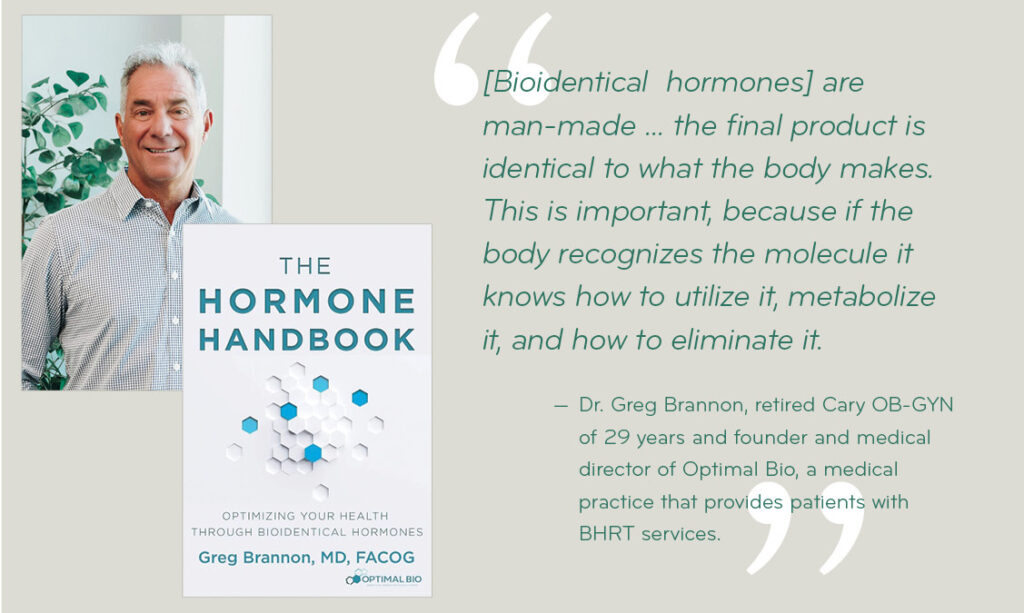Article:
Menopause and Hormone Therapy: Which Approach is Right for You?
BY ELIZABETH BRIGNAC
At the age of 53, Raleigh attorney Jenny Leisten wakes up 20 times a night due to hot flashes. “It’s incredible how hot you become,” she says. As a result, for the past three years, she’s been exhausted. “It’s … probably why menopausal women are known to be pretty angry and muddle‑headed. I don’t have enough sleep!” she says.
Hormone therapies supplement the body’s diminished estrogen and progesterone supplies in ways that help mitigate menopause’s negative effects. Hormones can be ingested as tablets, inserted via rings, implanted in the uterus, or applied locally to affected areas as patches, creams, gels or sprays. But before evaluating the options available to them, women must decide whether to utilize hormone therapy. For years, people experiencing menopause took hormone-based medications as a matter of course. Over the past two decades, however, that number has plummeted due to risks women associate with hormone use, including breast cancer, strokes, blood clots and cardiovascular disease.
“I decided that the risks were not worth it, because it has been associated with a slightly increased cancer risk,” says Leisten, who considered and rejected hormone therapy. “It’s so concerning how few studies are out there about menopause.” “I’m pretty risk‑averse,” she adds.
Every OB-GYN interviewed for this article emphasized their concern that women today are under-utilizing hormone therapies as a resource for managing menopause symptoms. Hormone therapy is not right for everyone, but for people in their 50s, the benefits can be great—and the risks lower than people might imagine.
What Are the Risks?
Why did women back off from using hormone therapy? In 2002, The Women’s Health Initiative (WHI), a groundbreaking series of studies focused on preventing health problems in postmenopausal women, published results associating the use of hormone therapy with a significantly increased risk of breast cancer, endometrial cancer, heart disease and strokes, among other health problems. As a result, women have sought hormone therapy much less often than they did prior to 2002.
Applying the WHI results too broadly to women experiencing menopause symptoms has led to errors because the relevant WHI study was designed to test hormone therapy’s potential to prevent cardiovascular disease in postmenopausal women. Many of the study’s subjects were in their 60s and 70s. The study did not widely test the effects of hormone therapy on younger, menopausal women.
Subsequent research has indicated that many of the health risks revealed by the WHI study are much lower for women taking hormone therapy in their 40s and 50s than for women over 60.
Hormone therapy risks vary greatly between patients. Take breast cancer, for example. There is an increased risk of breast cancer for women younger than 60 who take progesterone, but its severity depends on the patient’s personal and family medical history and their overall health. For some women, taking regulated amounts of progesterone increases your risk of breast cancer “no more than drinking a glass of wine every day increases your risk,” says Dr. Lucy Schenkman, a Duke Health OB-GYN who has been practicing for 14 years. For others—people who have had breast cancer already, for example, or people who have an elevated genetic predisposition to estrogen-responsive breast cancer—the risks are greater.
Hormone therapy today offers women many options worth exploring, even for women at risk for related health problems.
Compounded vs. Traditional Hormone Therapies
As women research hormone therapy options, they are likely to encounter companies offering compounded bioidentical hormone replacement therapy (BHRT). Compounded hormone therapies are designed to accommodate each patients’ specific needs rather than offering standardized hormone mixtures. Compounding pharmaceutical companies prepare medications according to individualized prescriptions. Traditional hormone therapies, by contrast, offer hormones balanced in standardized amounts.
Compounded hormone therapies are not regulated by the Food and Drug Administration. The FDA does regulate traditional hormone therapies, including those that utilize bioidentical hormones, which helps keep the hormone balances within safe ranges. “You don’t actually know how much hormone you’re getting” with compounded hormones, says Schenkman, “[Traditional hormone therapies] have gone through the appropriate studies and regulations, and you know how much estrogen you’re getting balanced with how much progesterone you’re getting. There’s definitely more information about what you’re putting in your body.”

What does it mean that BHRT therapies are “bioidentical”?
Bioidentical hormones are created from plant sources to be identical to hormones in the human body. “Even bioidentical [hormones] are man-made,” says Dr. Greg Brannon, a retired Cary OB-GYN of 29 years and founder and medical director of Optimal Bio, a medical practice that provides patients with BHRT services. “But the final product is identical to what the body makes.” He argues, “This is important, because if the body recognizes the molecule it knows how to utilize it, metabolize it, and how to eliminate it.” Synthetic hormones, by contrast, are not identical to the hormones our bodies produce. The term “bioidentical” (an unregulated label) is often used synonymously with compounded hormone therapies, though bioidentical hormones are used in some traditionally manufactured therapies as well.
Dr. Stephanie Faubion, director of the Mayo Clinic’s Center for Women’s Health, writes in an email: “FDA–approved forms of hormone therapy are under-prescribed, and there is no real benefit, [but potential harm in] using non–FDA approved and non-regulated hormone therapy preparations.” She adds, “We have good data on current forms of HT [hormone therapy] that are under-prescribed. That should be the point [of hormone therapy–related discussions].”

Pellet Hormones
BHRT products are sometimes administered as “pellet hormones”—compounded hormones injected as pellets into the body and absorbed over several months. These pellets usually contain hormone mixtures, including estrogen and testosterone, in larger amounts than in other hormone therapies. Brannon argues that the effects of aging are largely due to hormone loss; citing research demonstrating that historically, people retained higher levels of many hormones than they do today, he argues that by administering higher doses of these hormones in balances tailored to individual needs, we can combat some effects of aging. “Your cell does not know its age chronologically if the environment stays youthful,” he says.
However, Dr. Anne Ford, a Menopause Society–certified OB-GYN at Duke Health who has been practicing for 25 years, warns that pellet hormones, while they can make patients feel good for a while, can sometimes have potentially dangerous effects. “The studies on which pellet hormone therapy relies are very biased. If you got an epidemiologist to look at these, they would say, ‘Here’s the flaw in this, and here’s the flaw in this, and you didn’t look at this.’”
“The problem with pellets is, once you put them in, you can’t get them out,” Ford adds. “And when you put in testosterone pellets, if you put someone over the physiologic state, they can get sick. There are a lot of things that can happen that are very bad if you give people too much of a hormone.”
Next Steps
With all the options available today and debates about the risks associated with them, how should a sleep-deprived menopausal woman proceed?
First, by taking her symptoms seriously. Women often want to “tough out” discomfort, but menopause’s effects can profoundly affect some women’s sex lives, relationships, work productivity and happiness. Seeking relief for menopause symptoms can also affect women’s long-term health. For example, the FDA has approved the use of hormone therapy to address the potential for hormone-related bone density problems and to prevent osteoporosis. And Schenkman notes that prolonged menopause symptoms can have long-term health effects of their own, citing the potential cardiovascular risks of prolonged sleep deprivation as one example.
Patients should take seriously the potential risks of hormone therapy. Rather than assuming all hormone therapy is too risky to attempt, however, Ford advises women with menopause symptoms to consult OB-GYNs for guidance on their options. “You want someone who understands hormone therapy and has an interest in it,” she says.
These practitioners can offer up-to-date information on available hormone treatments. Treatments today vary greatly in how they balance hormones, the types of hormones used, and how hormones are applied. Women have many options in terms of treating menopause symptoms in ways that minimize risk factors.



